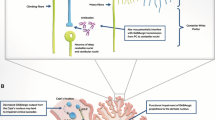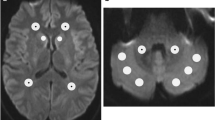Abstract
The “hot cross bun” sign (HCBs) is a cruciform hyperintensity on T2-weighted imaging within the pons initially found in patients diagnosed as multiple system atrophy. However, recent findings have broadened the disease spectrum presented with HCBs. Here is a case report at an academic medical center. Cerebral magnetic resonance imaging (MRI), electroneuromyography, serum, and CSF analysis were performed. Literature is comprehensively reviewed. We investigated a woman presented with blurred speech and cerebellar ataxia. Her MRI showed the vertical line of HCBs 2 weeks after disease onset and gradually enhanced, presenting as an intact HCBs in a year. Glutamic acid decarboxylase 65-kDa isoform (GAD65) antibody IgG was detected in serum and CSF. The patient was diagnosed as GAD65 associated cerebellar ataxia and treated with corticosteroid and rituximab. We found 6 previously reported autoimmune cerebellar ataxia patients with HCBs. Anti-KLHL-11, anti-Homer-3, anti-Ri, and anti-Amphiphysin were associated. All patients had cerebellar ataxia with other neurological symptoms. Five patients were diagnosed with tumor. First-line immunotherapy including corticosteroid, intravenous immunoglobulin, and plasma exchange for most patients was unsatisfied. This case highlights the importance of considering GAD65 IgG evaluation in patients with progressive cerebellar syndrome and HCBs. Early diagnosis and therapy are challenging but imperative. Further studies are required in regard to therapeutic management.



Similar content being viewed by others
Data Availability
Data will be shared by the corresponding author upon reasonable request.
References
Shrivastava A. The hot cross bun sign. Radiology. 2007;245:606–7. https://doi.org/10.1148/radiol.2452041856.
Lee YC, Liu CS, Wu HM, Wang PS, Chang MH, Soong BW. The ‘hot cross bun’ sign in the patients with spinocerebellar ataxia. Eur J Neurol. 2009;16:513–6. https://doi.org/10.1111/j.1468-1331.2008.02524.x.
Horimoto Y, Aiba I, Yasuda T, Ohkawa Y, Katayama T, Yokokawa Y, Goto A, Ito Y. Longitudinal MRI study of multiple system atrophy - when do the findings appear, and what is the course? J Neurol. 2002;249:847–54. https://doi.org/10.1007/s00415-002-0734-0.
Zhu S, Li H, Deng B, Zheng J, Huang Z, Chang Z, Huang Y, Wen Z, Liang Y, Yu M, Chan LL, Tan EK, Wang Q. Various diseases and clinical heterogeneity are associated with “hot cross bun”. Front Aging Neurosci. 2020;12:592212. https://doi.org/10.3389/fnagi.2020.592212.
Prasad S, Rossi M. The hot cross bun sign: a journey across etiologies. Mov Disord Clin Pract. 2022;9:1018–20. https://doi.org/10.1002/mdc3.13596.
Budhram A, Sechi E, Flanagan EP, Dubey D, Zekeridou A, Shah SS, Gadoth A, Naddaf E, McKeon A, Pittock SJ, Zalewski NL. Clinical spectrum of high-titre GAD65 antibodies. J Neurol Neurosurg Psychiatry. 2021;92:645–54. https://doi.org/10.1136/jnnp-2020-325275.
Bai L, Ren H, Liang M, Lu Q, Lin N, Liu M, Fan S, Cui R, Guan H. Neurological disorders associated with glutamic acid decarboxylase 65 antibodies: clinical spectrum and prognosis of a cohort from China. Front Neurol. 2022;13:990553. https://doi.org/10.3389/fneur.2022.990553.
Majed M, Madhavan AA, Pittock SJ, Dubey D. “Hot cross bun” sign in a patient with Kelch-like protein 11 rhombencephalitis. Mayo Clin Proc. 2022;97:122–3. https://doi.org/10.1016/j.mayocp.2021.11.024.
Liu Y, Huang D, Wu L. Occult breast cancer with anti-ri antibody positivity and pontine hot cross bun sign. JAMA Neurol. 2023;80:207–8. https://doi.org/10.1001/jamaneurol.2022.4663.
Liu M, Ren H, Lin N, Tan Y, Fan S, Guan H. The “hot cross bun sign” in patients with autoimmune cerebellar ataxia: a case report and literature review. Front Neurol. 2022;13:979203. https://doi.org/10.3389/fneur.2022.979203.
Liu M, Ren H, Fan S, Zhang W, Xu Y, Zhao W, Guan H, Encephalitis CG. Neurological autoimmunity associated with Homer-3 antibody: a case series from China. Neurol Neuroimmunol Neuroinflamm. 2021:8. https://doi.org/10.1212/NXI.0000000000001077.
Ishikawa H, Mandel-Brehm C, Shindo A, Cady MA, Mann SA, Niwa A, Miyashita K, Ii Y, Zorn KC, Taniguchi A, Maeda M, Wilson MR, DeRisi JL, Tomimoto H. Long-term MRI changes in a patient with Kelch-like protein 11-associated paraneoplastic neurological syndrome. Eur J Neurol. 2021;28:4261–6. https://doi.org/10.1111/ene.15120.
Ishikawa H, Kawada N, Taniguchi A, Odachi K, Mizutani A, Asahi M, Tomimoto H. Paraneoplastic neurological syndrome due to burned-out testicular tumor showing hot cross-bun sign. Acta Neurol Scand. 2016;133:398–402. https://doi.org/10.1111/ane.12469.
Schlapakow E, Keil VC, Paus M, Kornblum C, Hattingen E, Klockgether T. Multiple system atrophy mimicry in MRI: watch out for paraneoplastic rhombencephalitis. J Clin Neurosci. 2020;76:238–40. https://doi.org/10.1016/j.jocn.2020.04.052.
Graus F, Titulaer MJ, Balu R, Benseler S, Bien CG, Cellucci T, Cortese I, Dale RC, Gelfand JM, Geschwind M, Glaser CA, Honnorat J, Höftberger R, Iizuka T, Irani SR, Lancaster E, Leypoldt F, Prüss H, Rae-Grant A, et al. A clinical approach to diagnosis of autoimmune encephalitis. Lancet Neurol. 2016;15:391–404. https://doi.org/10.1016/s1474-4422(15)00401-9.
McKeon A, Tracy JA. GAD65 neurological autoimmunity. Muscle Nerve. 2017;56:15–27. https://doi.org/10.1002/mus.25565.
Takao M, Kadowaki T, Tomita Y, Yoshida Y, Mihara B. ‘Hot-cross bun sign’ of multiple system atrophy. Intern Med. 1883;2007:46. https://doi.org/10.2169/internalmedicine.46.0514.
Dubey D, Wilson MR, Clarkson B, Giannini C, Gandhi M, Cheville J, Lennon VA, Eggers S, Devine MF, Mandel-Brehm C, Kryzer T, Hinson SR, Khazaie K, Hales C, Kattah J, Pavelko KD, Andrews P, Eaton JE, Jitprapaikulsan J, et al. Expanded clinical phenotype, oncological associations, and immunopathologic insights of paraneoplastic Kelch-like protein-11 encephalitis. JAMA Neurol. 2020;77:1420–9. https://doi.org/10.1001/jamaneurol.2020.2231.
Dalmau J, Graus F. Antibody-mediated encephalitis. N Engl J Med. 2018;378:840–51. https://doi.org/10.1056/NEJMra1708712.
H-sJ SYR, Kim YH. Hot cross bun sign following bilateral pontine infarction: a case report. Journal of. Mov Disord. 2013;6:37–9.
Dik A, Widman G, Schulte-Mecklenbeck A, Witt JA, Pitsch J, Golombeck KS, Wagner J, Gallus M, Strippel C, Hansen N, Monig C, Rauber S, Wiendl H, Elger CE, Surges R, Meuth SG, Helmstaedter C, Gross CC, Becker AJ, Melzer N. Impact of T cells on neurodegeneration in anti-GAD65 limbic encephalitis. Ann Clin Transl Neurol. 2021;8:2289–301. https://doi.org/10.1002/acn3.51486.
Sugiyama A, Yokota H, Yamanaka Y, Mukai H, Yamamoto T, Hirano S, Koide K, Ito S, Kuwabara S. Vertical pons hyperintensity and hot cross bun sign in cerebellar-type multiple system atrophy and spinocerebellar ataxia type 3. BMC Neurol. 2020;20:157. https://doi.org/10.1186/s12883-020-01738-9.
Zhu S, Deng B, Huang Z, Chang Z, Li H, Liu H, Huang Y, Pan Y, Wang Y, Chao YX, Chan LL, Wu YR, Tan EK, Wang Q. “Hot cross bun” is a potential imaging marker for the severity of cerebellar ataxia in MSA-C. NPJ Parkinsons Dis. 2021;7:15. https://doi.org/10.1038/s41531-021-00159-w.
Acknowledgements
We thank the patient for granting permission to publish this information.
Funding
This work is supported by National Natural Science Foundation of China (No. 82101487), Natural Science Foundation of Shandong Province, China (ZR2021QH161), and Taishan Scholar Program of Shandong Province (tsqn202211318).
Author information
Authors and Affiliations
Contributions
Ruo-Nan Duan: Conceptualization, Data Curation, Formal Analysis, Funding Acquisition, Writing – Original Draft Preparation
Jing-Zhen He: Formal Analysis
Li-Li Cao: Conceptualization, Writing – Review & Editing
Corresponding author
Ethics declarations
Consent to Participate
The patient gave written informed consent for publication of medical information and images.
Conflict of Interest
None to declare
Additional information
Publisher’s Note
Springer Nature remains neutral with regard to jurisdictional claims in published maps and institutional affiliations.
Rights and permissions
Springer Nature or its licensor (e.g. a society or other partner) holds exclusive rights to this article under a publishing agreement with the author(s) or other rightsholder(s); author self-archiving of the accepted manuscript version of this article is solely governed by the terms of such publishing agreement and applicable law.
About this article
Cite this article
Duan, RN., He, JZ. & Cao, LL. “Hot Cross Bun” Sign in a Patient with Glutamic Acid Decarboxylase 65-KDa Isoform Associated Cerebellar Ataxia: Case Report and Review of the Literature. Cerebellum (2023). https://doi.org/10.1007/s12311-023-01631-4
Accepted:
Published:
DOI: https://doi.org/10.1007/s12311-023-01631-4




